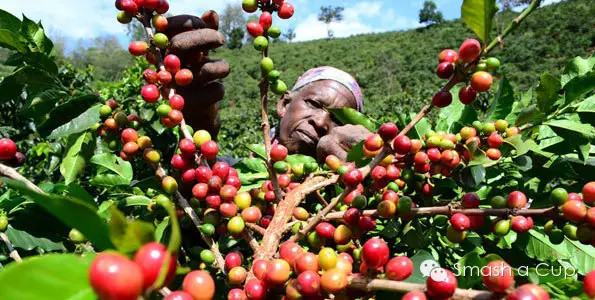Papua New Guinea, Papua New Guinea, India, Ken, Tanzania, Tibika.
The term "fine coffee" was first put forward by Ms. Knudsen of the United States in Coffee and Tea magazine. At that time, Ms. Knudsen, as a coffee buyer of B.C. Ireland in San Francisco, was very dissatisfied with the neglect of the quality of raw coffee in the industry, and even some big roasters mixed a large amount of Robesda beans in the comprehensive beans, so she put forward the concept of fine coffee to advocate the improvement of the quality of the industry. This term is used to describe coffee beans with distinctive flavor characteristics that grow in a special environment. Its use in international coffee conferences makes it spread rapidly.
In fact, according to Ms. Knudsen, people started drinking fine coffee, but later, due to the growing demand for coffee, the discovery and use of new coffee varieties led to the decline of coffee quality. later, people even began to dislike this bad coffee and began to turn to other drinks. In this case, Ms. Knudsen re-made people realize the value of boutique coffee, which led to a boutique coffee boom. In the United States, there are enterprises and stores in pursuit of boutique coffee represented by Starbucks. The market for boutique coffee is also growing. In the 1990s, with the rapid increase of boutique coffee retailers and cafes, boutique coffee has become one of the fastest growing markets in the catering service industry, reaching $12.5 billion in the United States alone in 2007. Now boutique coffee has become the fastest growing coffee market. Coffee producing and importing countries around the world are aware of the great potential of the boutique coffee market, and continue to make efforts to the production and production of boutique coffee.
Papua New Guinea (Papua New Guinea) aroma 3.5 minutes brightness 3.5 minutes mellow 3.5 minutes flavor 4.5 points aftertaste 4 points
Suitable for baking: City/Full city New Guinea beans can be baked in a wide range, from soft and well-balanced city to full city with a well-balanced flavor, and even re-baking with oil, depending on your preference.
New Guinea is also an outlier. Coffee estates are numerous, large and small in scale, and most of the small estates produce washed organic beans with strong flavor but no local flavor. These small estates also produce a small amount of sun beans, which are more varied and delicate than water-washed beans; the taste of large manor coffee is more clean and delicate, but some people think that it has less personality. Basically, Babu coffee is lighter than java beans, somewhat similar to good Central American beans. Most of the coffee trees in the area come from the Tibica seed of the Jamaican Arabica bean, mixed with the Arabica bean from Tanzania. There are also some new hybrids or Indian Ken specialties.

Important Notice :
前街咖啡 FrontStreet Coffee has moved to new addredd:
FrontStreet Coffee Address: 315,Donghua East Road,GuangZhou
Tel:020 38364473
- Prev

Introduction of Ugandan Coffee beans with mild Climate and suitable for growing Coffee
Uganda is a landlocked country in eastern Africa, straddling the equator, bordering Kenya to the east, Tanzania and Rwanda to the south, the Democratic Republic of the Congo to the west and Sudan to the north. Most of the territory is located in the Central African Plateau, with lakes, with an average elevation of 1000,000,000 meters above sea level. There are many lakes and plateaus in the mountains, which are known as the water villages of the plateau. The western branch of the East African Rift Valley runs through the western border, with many rivers and lakes at the bottom of the valley. There is a Victor in Uganda.
- Next

Tropical fruit, fermented Sidamo coffee beans introduce boutique coffee
Sidamo Cabedo is a small coffee cooperative in a small town in Dala, Sidamo Province. each small coffee farmer here has an average planting area of about 0.6 hectares and is composed of hundreds of coffee farmers. it is planted at an altitude of nearly 2000 meters above sea level. the climate temperature difference is large, and the soil is fertile, providing an excellent growing environment, and the raw bean itself exudes a strong aroma of raisins and fermented wine.
Related
- Does Rose Summer choose Blue, Green or Red? Detailed explanation of Rose Summer Coffee plots and Classification in Panamanian Jade Manor
- What is the difference between the origin, producing area, processing plant, cooperative and manor of coffee beans?
- How fine does the espresso powder fit? how to grind the espresso?
- Sca coffee roasting degree color card coffee roasting degree 8 roasting color values what do you mean?
- The practice of lattes: how to make lattes at home
- Introduction to Indonesian Fine Coffee beans-- Java Coffee producing area of Indonesian Arabica Coffee
- How much will the flavor of light and medium roasted rose summer be expressed? What baking level is rose summer suitable for?
- Introduction to the characteristics of washing, sun-drying or wet-planing coffee commonly used in Mantenin, Indonesia
- Price characteristics of Arabica Coffee Bean Starbucks introduction to Manning Coffee Bean Taste producing area Variety Manor
- What is the authentic Yega flavor? What are the flavor characteristics of the really excellent Yejasuffi coffee beans?

